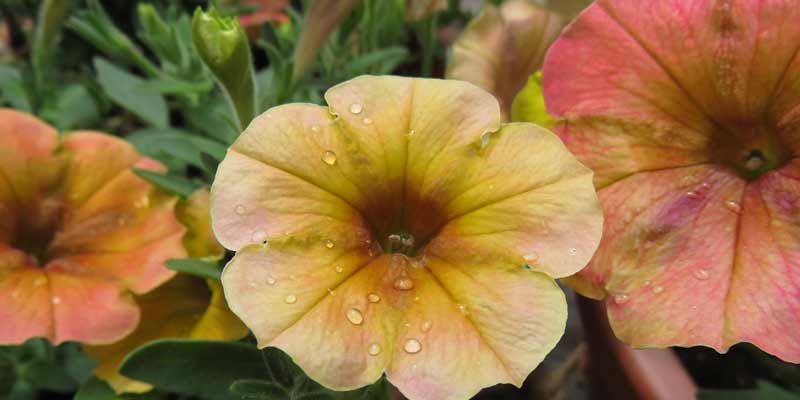Beloved additions to gardens, hanging baskets, and containers are petunias with their cascading blooms and vibrant colors. Thriving in various growing conditions—these resilient annuals bring joy and beauty to outdoor spaces. Nonetheless, maintaining the health; vigor; and abundant flowering of petunias requires an understanding of their water needs, a crucial factor indeed.
This article delves into an exploration of petunias’ watering requirements, the factors that influence their need for water, and best practices to guarantee optimal growth and blooming: a comprehensive approach towards effective irrigation strategies.
The Importance of Water for Petunias
All plants, including petunias, necessitate water for their growth and survival. Petunias in particular depend on water to carry out several critical functions as most flowering annuals do:
Cellular Processes: As a primary component of plant cells, water actively facilitates vital physiological processes photosynthesis, nutrient uptake, and metabolic functions.
Turgor Pressure: Adequate water uptake upholds turgor pressure within plant cells, which in turn maintains firmness and upright posture of stems and foliage. The proper turgor pressure is essential to bolster the structure of petunia plants; without it, wilting becomes inevitable.
Nutrient Transport: Water, as a medium for nutrient transport, ensures the distribution of essential nutrients from soil to plant roots and throughout the entire organism. This process facilitates growth and flowering by providing plants with the vital components they require.
Understanding the Watering Needs of Petunias
Several factors must be considered to understand the watering needs of petunias, like many flowering annuals, which have specific requirements for supporting healthy growth and flowering. While petunias thrive in consistently moist soil; overwatering can make them susceptible to root rot and other moisture-related issues. These several factors encompass:
Soil Type and Drainage
Petunias flourish in soil that drains well, ensuring excess water escapes freely to prevent waterlogging and root suffocation. Ideally, one should choose sandy or loamy soils with excellent drainage for petunias.
However, it’s important to note heavy clay soils could pose a risk as they tend to retain excessive amounts of water — this increases the likelihood of root rot. As such, consider these factors when determining your soil type and drainage strategy.
Environmental Conditions
Factors such as temperature, humidity, and sunlight intensity dictate the rate of evaporation; they also determine how petunias absorb water. In periods characterized by high temperatures or intense heat, increased loss through transpiration necessitates more regular watering for petunias.
Plant Size and Growth Stage
Established petunia plants, boasting extensive root systems, may demand more regular watering than their freshly planted seedling or transplant counterparts due to their larger size and advanced growth stage.
Moreover, petunias engaged in active growth stages – flowering or vegetative expansion specifically – might necessitate increased water intake for the sustenance of metabolic processes.
Determining When to Water Petunias
Assessing soil moisture levels and responding to specific plant needs are integral in determining the optimal watering schedule for petunias. To gauge soil moisture effectively, several methods exist; these can aid us in establishing if additional watering is necessary:
Visual Inspection: Examine the soil surface and plant foliage visually: look for signs of dryness–wilting leaves, drooping stems, or parched crumbly soil. When you detect petunias with a top inch of dry soil on their root zone, ensure thorough watering is carried out to reach it.
Finger Test: Gauge the moisture levels by inserting your finger into the soil near the base of petunia plants; initiate this action when you perceive a need for it. If, upon your inspection, you detect dryness to a depth of 1-2 inches in the soil – then indeed, that’s an indicator—it is time to provide water. If the soil feels moist or soggy, refrain from watering: overwatering can precipitate root rot and various other issues.
Container Weight Assessment: Lift the pot holding your petunias to examine its weight; notably, dry soil–being lighter than moist soil–can serve as an indicator for necessary watering due to a discernible difference in weight.
For containers housing petunias: lift the pots and gauge their weights. It is worth noting that dry soil—lighter than moist soil—serves as an indicator for required watering; a significant contrast in weights will indeed confirm this need. Ensure the root ball achieves thorough saturation by watering it until water drains from the container’s bottom.
Best Practices for Watering Petunias
To ensure optimal growth and flowering, follow these best practices for watering petunias:
Water Deeply and Infrequently
Opt for deep, infrequent watering of petunias to foster their root system’s depth and enhance drought tolerance. Administer the water directly at the plant’s base – whether through a hose or watering can – ensuring that it reaches strategically towards its root zone; however, take care not to dampen foliage as this minimizes risks associated with foliar diseases.
Morning Watering
In the early morning, you should water petunias to mitigate water loss via evaporation; this also enables foliage to promptly dry, a measure that diminishes fungal disease risks. Ensure avoidance of late afternoon or evening watering as overnight dampness on the leaves may encourage fungus growth and promote disease development.
Mulching
Surround petunia plants with a layer of organic mulch–shredded bark or compost, for instance; this strategy not only conserves soil moisture but also suppresses weed growth and regulates soil temperature.
Furthermore, by preventing soil compaction and erosion, mulching promotes healthy root development while enhancing water retention.
Avoid Overwatering
Resist the temptation to overwater petunias. Excessful moisture can induce root rot, fungal diseases, and nutrient leaching. Instead, permit a drying period by letting the top inch of soil remain dry between waterings; adjust this frequency in response to environmental conditions and plant requirements.
Weather Conditions Monitoring
Vigilantly consider weather forecasts and environmental conditions; adapt your watering practices during hot, dry spells or significant rainfall. Employ the use of rain gauges, or moisture meters, to track both rainfall levels and soil moisture content. This guarantees that petunias receive an appropriate amount of water—not too little, not too much.
Signs of Overwatering and Underwatering:
Essential to promptly address watering issues and prevent damage to petunia plants is the recognition of signs indicating overwatering or underwatering:
Overwatering: Signs of overwatering manifest as wilting despite the soil’s moisture, foliage yellowing or browning, a foul smell emanating from saturated soil, and root rot resulting in mushy roots. Suspecting overwatering requires one to halt watering and let the soil dry out before resuming; if necessary, enhancing soil drainage becomes imperative.
Underwatering: Symptoms of underwatering manifest as wilted, limp foliage; soil appears dry and crumbly, and growth stunts. Should petunias exhibit these signs, prompt and thorough watering is necessary to rehydrate the soil: this will revive the plants.
Conclusion
Watering critically impacts the health, vigor, and flowering of petunias, it ensures they receive vital moisture for growth. To nurture robustly blooming plants throughout a season; gardeners must understand petunia’s water requirements, monitor soil moisture levels – an indicator of their hydration needs – and employ proper watering techniques.
When attention is paid to care, specifically consistent watering practices, petunias reward not only with abundant blooms but also with enduring beauty that delights both gardener and admirer alike: A charming presence enhanced by vibrant colors marks these radiant flowers in any landscape or container setting.



Leave a Reply